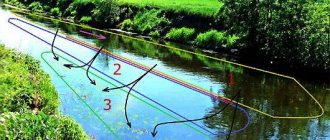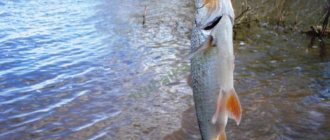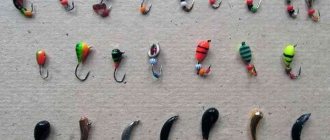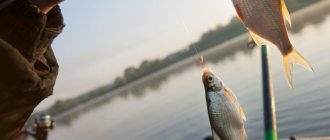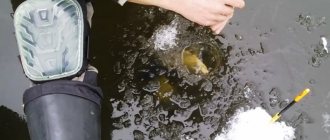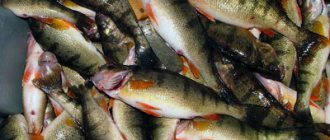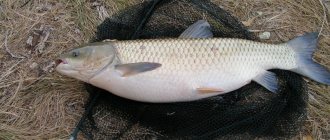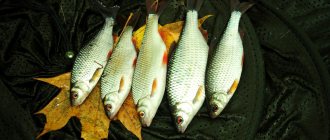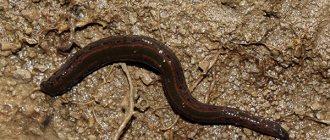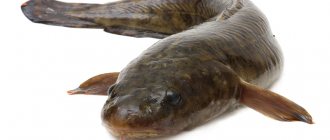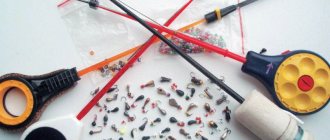The bream is a young bream from the carp family. It got its name from its weight - up to 500 grams, above that comes keel, chebak and bream, the catching of which requires appropriate skills, preparation of certain gear and feeding the place.
Our article provides detailed information regarding the correct fishing of white bream, the best time for fishing in summer or winter, what kind of bait can attract, in what places to fish on a river or in reservoirs, what kind of tackle can be used: a donk, a feeder or a float rod.
Fishing Features
This particular species of juvenile is cautious, capricious and unpredictable. It is found in deep reservoirs closer to holes, rocky and clay bottoms. It is difficult to predict its habitat for successful fishing. It is better to choose uneven places with a calm current, creeks overgrown with reeds.
When fishing, due attention should be paid to bait . Wheat porridge, bran, crackers, and cake are suitable. To make the mixture heavier, it is useful to add dry crushed clay. To destroy the compressed bait in water, add a little dry kvass or citric acid, baking soda.
Breeders are attracted by circles of food particles on the water, obtained as a result of the reaction when the bait interacts with water. But, the base for bait must be alive, and the bait must be active. Chopped worms, small bloodworms, and maggots are attached to the hook.
What to use to catch white bream in August?
In August it lives in bottom waters. At dusk it swims to the shore, and during the day it goes deeper. The sandy bottom attracts little bream; the muddy bottom is what it prefers. The bait for fishing can be varied. Not only bloodworms or earthworms are suitable for this.
You can also use barley, peas or steamed wheat grains . But the most effective are sandwich baits, consisting of several types of bait.
Age indicators for spawning
At the beginning of May the bite becomes unstable. The fish are starting to prepare for spawning, but fishing for bream and bream at this time towards the end of the month is as effective as ever.
Depending on age indicators, fish spawn in periods:
- medium-sized individuals (loosestrife) go first to spawn;
- larger individuals (birch trees) come second;
- the smallest representatives go last.
It is at the end of the month that the post-spawning period of individuals falls. After a couple of days, the fish will regain its strength, and fishing will be more successful.
When to fish: biting calendar by fishing season
The bream bites most actively in the spring, in May. Location near edges, seaweed, shell banks, holes, river beds. It is better to fish in calm, windless weather.
The fish can be frightened by even slight fluctuations in the water. In the spring, you need to look for a place where fish feed and to collect them in a heap, it is advisable to immediately feed this place with bloodworms. In strong currents, you can add crackers, bran, and milk powder. In the absence of bloodworms, pearl barley, rolled oats, and chopped worms are suitable.
As the summer season ends, the fish begin to feed intensively and by autumn they move further from the shores to quiet waters, closer to the muddy bottom.
Finding her becomes more difficult. The catches are better in the morning, while the fish are in shallow water. Closer to noon, the bream goes to the depths.
It is good to fish from the shore using a float or bottom fishing rod. It is advisable to use large hooks.
But in autumn there are more bites from the boat. An echo sounder helps you find schools of bream. At this time, the fish go to certain places to feed.
You need to choose one place for complementary feeding. Balls of porridge and dough should be quite dense, without adding any odorous substances. You can only add a pinch.
In the fall, the bream goes for worms and bloodworms, but after a couple of bites, it can cast the bait and swim away. After some time, return to the same place again. The main thing is that when he returns, the bait lies on the bottom intact and intact.
During the winter season, fish migrate. Her route is unpredictable. Often she simply swims through fishing spots. The food should be placed into the holes made frequently, 1-2 times every 3 hours, maintaining a distance of 4-5 meters between the holes.
Feeding for breams in winter is usually in the morning (at 10 o'clock), and on the edge - closer to lunch. Somewhere in January you simply cannot do without bait. Fishermen feed up to 15-20 holes at one time.
Choosing a good place, feeding in a timely manner, choosing suitable gear - this is the success of winter fishing and, of course, without much experience it is quite difficult to foresee all this. Fishing will require strength, and most importantly, patience; when catching bream, it is simply necessary.
When to catch
The white bream is most active on sunny days, as well as during periods of warming. At the same time, it actively bites during the period when the ice on the reservoir begins to melt. During these periods, going out onto the rivers is quite dangerous, and the ice on the lakes is still strong. This is due to the fact that the fish senses the approach of spring and begins to be especially active.
And yet, bream can be caught all winter long. Fishing at night may be the most productive, but such anglers practically do not exist. Each of them prefers to fish during the day, starting from 10 o'clock in the morning and ending at 16 o'clock in the evening. At the same time, the bream can go on a break, somewhere around 12 o’clock in the afternoon. And around one o'clock in the afternoon he starts taking bait again. Although it can be noted that these figures for each reservoir may be different.
Tackle and equipment for catching bream
Typically, long casts are not required to catch bream. The fishing line is suitable 0.1–0.4 mm in thickness, hook numbers 3.4. Tackle: float rod, donka, jig.
- The float rod should be light, quick to set up, 3–5 m long with a light reel. It is possible to use a fly rod up to 7 m in length. For fishing at night, you can use luminous floats.
- Bottom tackle or feeder is from 3 to 4.4 meters in length, the distance between the hook and the sinker is no more than 10 cm. For fishing in deep waters, you can use sliding equipment and other wiring. 50-100 g of dough is used as a feeder. Fishing is successful both in still water and in strong currents.
- Fishing with a jig. It is good to fish with a jig from a boat, in the thickets. The length of the rod with a fast action is from 3 to 3.5 m, the reel is inertia-free. It is not necessary to have a float. Instead of a sinker, you can use large jigs. When fishing in winter, the fishing rod should be equipped with a Mylar plate nod up to 15 cm long and a fishing line thickness of 0.08–0.1 mm. Tungsten jigs are convenient. If there is a current, the following models are also suitable: Drobinka, Grushka, Uralochka.
Fishing for bream in spring
In spring, the bream begins to actively feed before spawning. You can count on a stable and active bite from mid-April. In May there is already a good bite, and fishermen are successfully catching it using all peaceful gear. It spawns a little later than roach, in May, when the water temperature warms up to 15 degrees.
The closer the spawning, the bolder the bream, which comes closer and closer to the shore. At this time, it can be caught with a fly rod. It feeds mainly on larvae and worms, which are available in sufficient quantities in warm regions in mid-spring.
When spawning occurs at the confluence of rivers and reservoirs, it is caught at the mouths of these rivers. In these areas, bream and bream actively feed before spawning. As soon as the water warms up to the desired level, schools of fish head to the spawning grounds. In medium and large rivers, breams gather near dams and holes, near oxbow lakes. There they lay their eggs.
When fishing with float fly tackle, you should choose a long rod 6-7 meters long. It is equipped with a fishing line with a diameter of 0.14 mm and a float with a carrying capacity of up to 2 grams. It is advisable to find a place where the current is small and there is a good food supply.
If there are trees and bushes, then there is a lot of natural food at the bottom of this section of the river. If there is a hole nearby, then this is generally an ideal place. The tackle should not be thrown into the pit itself, but slightly to the side of it, where there is no strong current. We use bream complementary food, dark for cold water. Mix it with soil and add, if available, bloodworms or chopped worms.
Before fishing, it is important to understand in which horizon the fish feed. That is, you need to fish at different depths, throwing gear at different distances. Having identified a promising point, we feed it. Only feed in small portions. We roll the bait into balls the size of a tangerine and throw 4-5 pieces, and then once every hour. You can bait several points and cast two fishing rods and thus determine where the fish are best caught.
Successful fishing of bream on bottom gear occurs at the end of April and May. You can catch it close to the shore. Before casting, you need to scan the bottom and feed a little. The classic baits at this time are bloodworms, maggots and worms, as well as their combinations.
As the water warms up, from mid-May you can also use vegetable baits: barley, air dough, vanilla dough and mastyrka. Foam plastic stands apart. This attachment is actively used by milkers and feeders in combination with maggots and worms. In warm weather, bloodworms no longer work as well as in cold water.
In the article fishing in spring
you can learn how to catch other fish at this time of year.
How to feed
Bait is an essential attribute for successful fishing. The bream lives in schools and is very cautious. The noise when pulling out the rod can immediately leave the place. To increase the catch, attract fish from long distances, and stimulate their appetite, bite activators containing pheromones that can take into account the behavior of the fish are used.
Balls of bait the size of a chicken egg are thrown into the water, but you shouldn’t count on a timid fish approaching them quickly. You need to wait, but there is no need to throw additional portions. The entire flock can be overfed. Throwing 1-2 balls every 45 minutes is enough to keep the fish in one place.
The bait should be:
- Shredded.
- Viscous, does not crumble in water.
- Fragrant, for 1 kg of complementary food you can add 2 tbsp vegetable oil. l., essential oil or fruit essence (a few drops) also roasted nuts up to 100 gr. The color should match the bottom.
Catching roach and bream in mid-water
Catching these fish is largely similar in terms of gear, but very different in fishing tactics, so let's start with roach.
It should be noted that not only in the dead of winter, but also on the first and last ice, roach often rises above the bottom and, like bleak in summer, begins to grab bait at different horizons. It occupies some horizon, but as soon as the bait gets into the hole, the roach begins to move up and down. The well-known method of catching roach using sinking bait is based on this.
The method involves feeding a hole in a pond without a current with a dry mixture of breadcrumbs and cake. The mixture slowly absorbs water, crackers and cake particles slowly sink to the bottom. A column of bait is formed in which the roach moves up and down.
The tackle used is a very small and light white jig. I have used tin jigs for many years. The shape of the jig does not matter much. Line with a diameter of 0.06-0.08 mm. This way they usually catch not large roach, up to 200 g, but a lot. When the roach approaches the bait, and the fishing depth does not exceed 3-4 meters, it is very effective to periodically add small portions of regular milk into the hole.
The fishing technique is very simple. A jig with one small bloodworm or burdock on a hook is lowered into the water without any hesitation. The jig simulates the fall of a large piece of bait. The line must be constantly tensioned so as not to lose the connection between the jig and the guard. If there is no bite, then the jig is again raised about a meter and a half and lowered again. It’s rare, but it’s possible to catch small bream this way, especially towards the end of winter, when it goes out to water reservoirs.
Fishing this way is good when the depth under the hole does not exceed six meters and the depth at which the fish is located is known exactly. It’s a different matter when the depth under the hole is large and it is unknown which horizon the fish prefers today. If there is no echo sounder, then you have to explore almost all fishing horizons. But the depth at which the fish is kept has been found. What to do now? There is no point in feeding the holes. If you feed with light bait, then until it reaches the required depth, it will disperse over a very large volume and, at best, distribute the fish over a large area. The concentration of fish directly under the hole can become negligible.
If you feed with heavy bait, it will quickly pass the “working” horizon and sink to the bottom. It is useless to hope that the fish will follow it.
The conclusion is that you just need to give up bait. Relatively large “no-attachment” jigs, “goats” and “devils” are used as gear when fishing in mid-water at great depths. It is difficult to answer the question of which bait will be better today. The experience of “local” fishermen helps a lot.
For example, on the Valdai and Velevskoye lakes, roach can be easily caught throughout the winter using large “Uralkas” of silver, light green and purple colors. It is characteristic that cambrics and beads on the hook do not improve the bite. It gets to the point that even a seventy-gram roach grabs silver perch spoons at a depth of 12-15 meters. Despite the fact that the depth to the bottom at the fishing site reaches 25-30 meters. The technique of playing with a jig at such a depth is practically no different from the technique of catching perch with “reelless” jigs from a depth of 3-5 meters. That is, the game is quite sweeping and fast. The roach shows its presence literally from three to five bait retrieves. There is no point in hatching fish in one place.
It is better to drill one hole after another. You just need to keep in mind that after catching the first fish, you should measure the depth to the bottom and remember it. It happens that the “working” depth is found, the fishing is successful, but then the moment comes when there is no bite in the new holes. If you measure the distance to the bottom in new holes, it turns out that it has changed sharply in one direction or another. And the fish no longer stay here. It would seem, what difference does it make to roaches, ten meters to the bottom or five, or twenty? But a fact is a fact, and it must be taken into account.
The only time in my practice I observed similar bream fishing on Ruza. The local grandfather watched from what depth the bream with bait was caught from the bottom, then about the depth and went to the riverbed. And I caught large bream in holes with a depth of about twenty meters with a descent of 10-12 meters. I caught it not with “devils”, but with a large black “Uralka” with red beads on the hook. The size of the “Uralka” was comparable to a perch spoon. This, I think, is an uncharacteristic case. Much more often other gear and other fishing tactics are used.
Moscow fishermen have become quite good at catching bream and large roach in mid-water above holes in reservoirs. Vivid examples of such fishing are fishing in the famous Rublevsky quarry, which is connected to the Moscow River near the Novorizhskaya highway. The second example is three pits at the Pyalovskoye Reservoir. Here the fish do not sink to the bottom almost the entire season, but stay at depths of 4-8 meters. By the end of winter, the ice becomes like a sieve of holes, and when the thaw comes, there is simply nowhere to drill new holes. As the fishermen themselves put it, bream are “chased” here, that is, anglers constantly move after a school of fish, which they themselves frighten with their accumulation. Fishing in such conditions, when fish can be caught only in a matter of seconds and the school is already passing, is only possible with either very heavy jigs with bloodworms, or with “devils”. But the bloodworm still needs to be attached, and in most cases the moving fish does not perceive the bloodworm as bait. What remains is “devil.”
It is important not only to “peep” the “working” descent of successful fishermen, but also to choose the right “devil” in size and color. It happens that fish bite better on larger bait, even in winter. But this is in famous places, and not everyone likes such hectic and offensive fishing. Therefore, there are masters who successfully catch the same white bream and large roach at mid-water in the vastness of the Istrinsky and Ozerninsky reservoirs.
Most anglers traditionally bait the holes and wait for the moment when the fish begins to take the bloodworm lying on the bottom, but this does not always happen. In the middle of winter, there are increasingly days when the bream does not want to sink to the bottom and stands at half-water. (We should not forget that even on the first ice the fish often stand at half-water.) Only if the holes are baited on solid ground, without silt, can you count on the fact that by the evening the bream and roach will approach these places, go down to the bottom and the bite will begin. What if the location is chosen incorrectly?
It would be more reliable to take a tackle with a small black or purple “devil” and look for fish above the holes, but in mid-water. The bites will most likely be rare, but the fish will be larger, and this is still better than spending the day near the float rig and not catching a single fish larger than the palm of your hand.
When fishing in mid-water, there is no point in hatching fish; you need to drill and drill new and new holes all the time. After biting and catching a fish, it makes sense to remember the hole and return to it after a while. In the wilderness, flocks rarely move and only when the water level changes. When the bites stop, it makes sense to take another tackle with a thinner line and a smaller “devil”. Sometimes, especially when fishing for roach, the “goat” becomes more effective. It is interesting that there are often cases when roach begins to be caught well on a black “devil”, and by lunchtime it begins to more accurately grab a beige or white “goat”.
And further. Almost all Moscow fishermen know that even on those days when the bream is caught from the bottom, with bait, by the evening it rises above the bottom and fishing at dusk becomes fishing at mid-water. Moreover, it is caught from baited holes, but at a height of one and a half to three meters above the bottom. In such cases, experienced fishermen change jigs and float rigs to fishing rods with “devils” and continue fishing until dark.
Fishing on the current also often turns into fishing in mid-water. What is this connected with? After all, it would seem that there should be no death in the rivers and that drives the fish up. There are two possible explanations. In rivers with a pronounced turbulent flow (Oka and other relatively shallow and fast rivers), fish food is distributed almost evenly throughout the middle part of the flow and its concentration is lowest at the very bottom and the ice itself. Fish in such rivers walk along the horizons and are caught when the bait falls under its nose.
Fishing in such conditions can only be done with very heavy spherical tungsten jigs or tungsten “devils.” “Devils,” it seems to me, are preferable due to the fact that their resistance in the water is not increased by the bait on the hook. Compared to “reelless” jigs, “devils” have the least resistance in the current, which means their movement in the water can be controlled and the desired game achieved.
The situation is different in rivers with a smooth and relatively weak current. Here, it seems to me that the reason for the rise of peaceful fish in mid-water should be considered either the dumping of heavy waste floating near the bottom, or the pressure of a predator. It is quite possible that schools of roach and bream, especially when moving along the river, rise under the pressure of schools of pike perch and large perch that stick to the bottom. Fishing in such conditions is almost the same as fishing in a reservoir without current and without bait. In addition to “devils” and “goats,” special, fairly large and elongated “no-attachment” jigs become effective. It’s good if there are a pair of movable beads on the hook of such a jig. It is better to use large beads. It stabilizes the tail of the jig during play, and the jig is always positioned against the current.
In all cases of fishing, it is useful to periodically change baits. Try to catch either with a “devil” or with a jig. Fish tastes may change throughout the day.
It should be noted that fishing in mid-water remains relevant not only in the dead of winter, but also until the appearance of the first spring banks.
A. Yanshevsky “ROG No. 03 - 2003”
Basic lures
- Animal origin , suitable for adding at water temperatures up to 20 degrees. Usually, to avoid souring, such baits are used for fishing in winter. Sandwiches are prepared from bloodworms, dung and earthworms, and maggots.
- Plant origin , used in the warm season - summer. This is bread crumb, dough, corn, canned peas, manastyrka, porridge made from semolina, buckwheat, oatmeal, millet, steamed corn, rye, wheat, oats.
Often fishermen combine baits. The choice of plant bait is difficult if the area is unfamiliar. A plant bait and maggot or worm are put on the hook.
Features of complementary feeding
A special feature of bream is their love for tasty and plentiful food. In closed reservoirs, these fish tend to change their parking places. However, they never ignore feeding areas.
Bream is cunning and cautious, so it is fed in the chosen place for about a week, but not less than 5 days. In this case, the bait is laid at a depth of three meters. Bream avoids shallow water, and there is a high probability of smaller fish eating the bait here.
Recommended reading: Equipment
So what does bream bite best on? The best bait is blizzard larvae, dung worms, maggots and blizzard larvae. In addition to the above, attachments made from dough with eggs, semolina porridge and peas (steamed) are also effective. It is recommended to use a No. 5 hook and give the dough stuck to it a pear shape.
Worms and maggots should be placed on the hook in a lump or in clusters. At the same time, it is unacceptable to leave even a small section of the hook open, since bream is sensitive to the smell of metal.
Two important conditions for successful bream fishing are a flexible rod and the location of the bait at the bottom of the reservoir. Flat bream bites like this: it stands upright and sucks in the bait simultaneously with the river water. The external sign of a bite is this: the float first lies on the water and then begins to sink.
